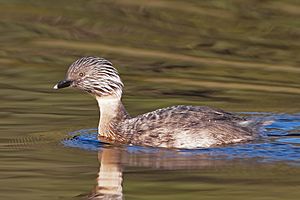Hoary-headed grebe facts for kids
Quick facts for kids Hoary-headed grebe |
|
|---|---|
 |
|
| Conservation status | |
| Scientific classification | |
| Genus: |
Poliocephalus
|
| Species: |
poliocephalus
|
 |
|
| Distribution of the hoary-headed grebe | |
The hoary-headed grebe (Poliocephalus poliocephalus) is a small water bird. It belongs to the grebe family. These birds get their name from the silvery-white streaks on their black heads. They look a bit like they have "hoary" or frosty hair!
Hoary-headed grebes live and raise their young in southern Australia and Tasmania. During the colder months, they can be found all over Tasmania. This bird is quite common in Australia, with about 500,000 of them living there. Their homes are similar to those of the Australasian grebe.
Contents
What Does the Hoary-headed Grebe Look Like?
The hoary-headed grebe is a small bird. It has dark grey and white feathers. Its eyes are brown, and it has a black patch under its chin. A thin black line runs down the back of its neck.
During the breeding season, adult birds grow special white streaks all over their heads. This is how they get their unique name. Young grebes, called juveniles, have a white chin and throat. Their faces also have stripes. Male grebes change their look after breeding. They lose the buff-colored chest and the white head lines. However, you can still spot them by a wide black bar on the back of their neck.
Where Do Hoary-headed Grebes Live?
You can find the hoary-headed grebe in all states and territories of Australia. They usually do not live in the dry, central parts of the country. These grebes prefer large open waters. They are often found away from the shoreline.
Their homes can be estuaries, which are where rivers meet the sea. They also live in brackish water, which is a mix of fresh and salt water. Of course, they also love freshwater areas. Sometimes, you might even see them in calm coastal seas. While they are common in Australia, they are much rarer in New Zealand.
What Do Hoary-headed Grebes Eat?
The hoary-headed grebe mostly eats small water creatures. These are called aquatic arthropods. They catch most of their food by diving deep underwater.
These birds usually feed during the day. If the light is not very good, they will often look for food right on the water's surface.
Hoary-headed Grebe Reproduction
Hoary-headed grebes build their nests and lay eggs from August to January. Their nests are like floating platforms. They are made from water weeds. These nests are similar to those built by the Australasian grebe.
The nests are usually built a bit away from the shore. They are often found among thin reeds or other plants. The plants help anchor the nest and hold it up. The top of the nest has a small dip. This dip is just above the water, so the eggs rest in water or dampness.
When a parent bird leaves the nest, it covers the eggs. It uses pieces of wet plants to hide them. This makes the nest look empty. If the sun is strong, the covered eggs stay warm and moist. This means the parents can leave them alone for a while.
The eggs are oval-shaped and white. They soon get stained brownish-yellow. A female grebe usually lays 2 to 5 eggs. The eggs hatch after 20 to 24 days of incubation. Each egg is about 39 mm long and 27 mm wide.
Is the Hoary-headed Grebe in Danger?
The hoary-headed grebe lives across a very large area. There is no sign that their numbers are dropping a lot. Because of this, their conservation status is listed as "Least Concern." This means they are not currently in danger of disappearing.
- Grebes of the World – Malcolm Ogilvie & Chris Rose ISBN: 1-872842-03-8
See also
 In Spanish: Zampullín canoso para niños
In Spanish: Zampullín canoso para niños


